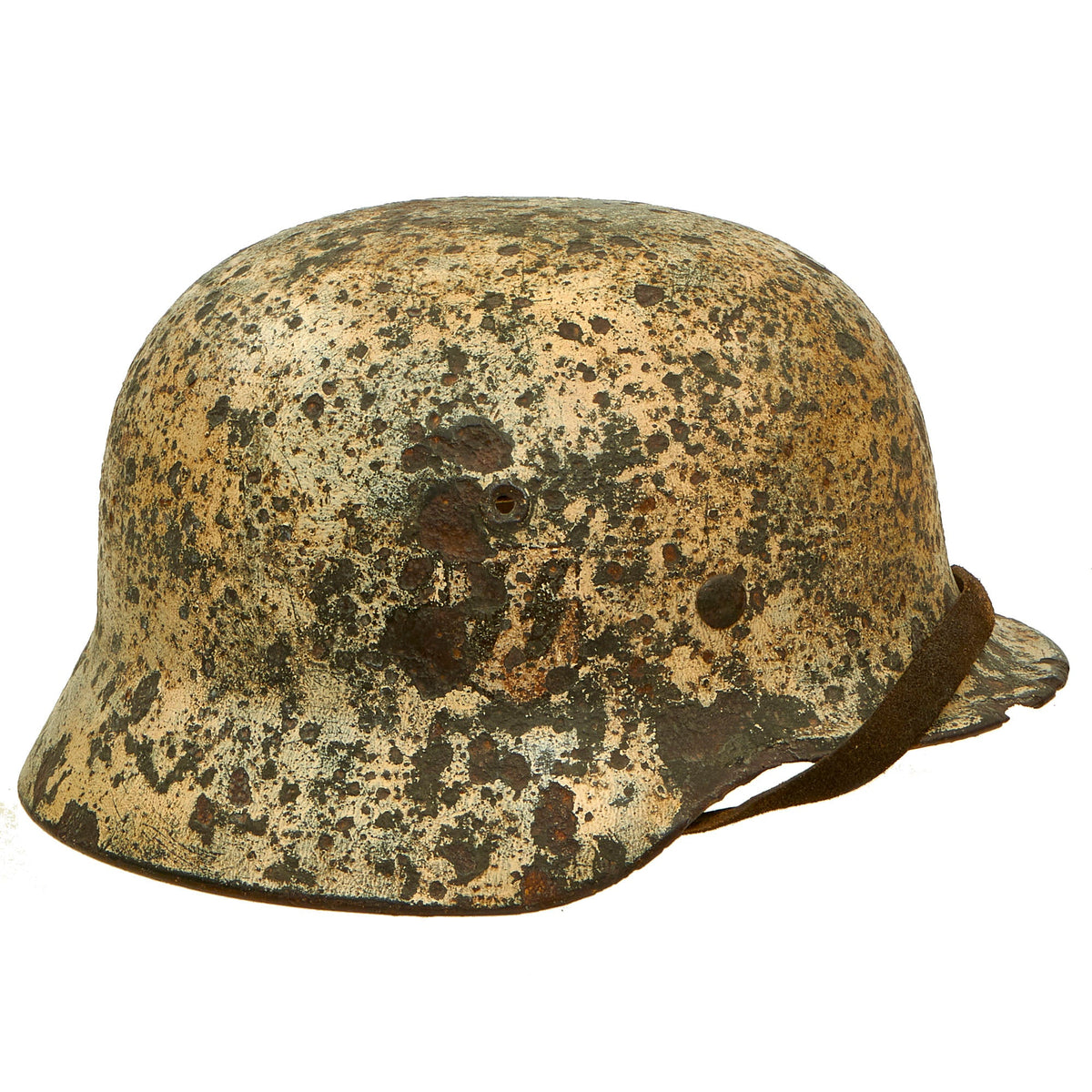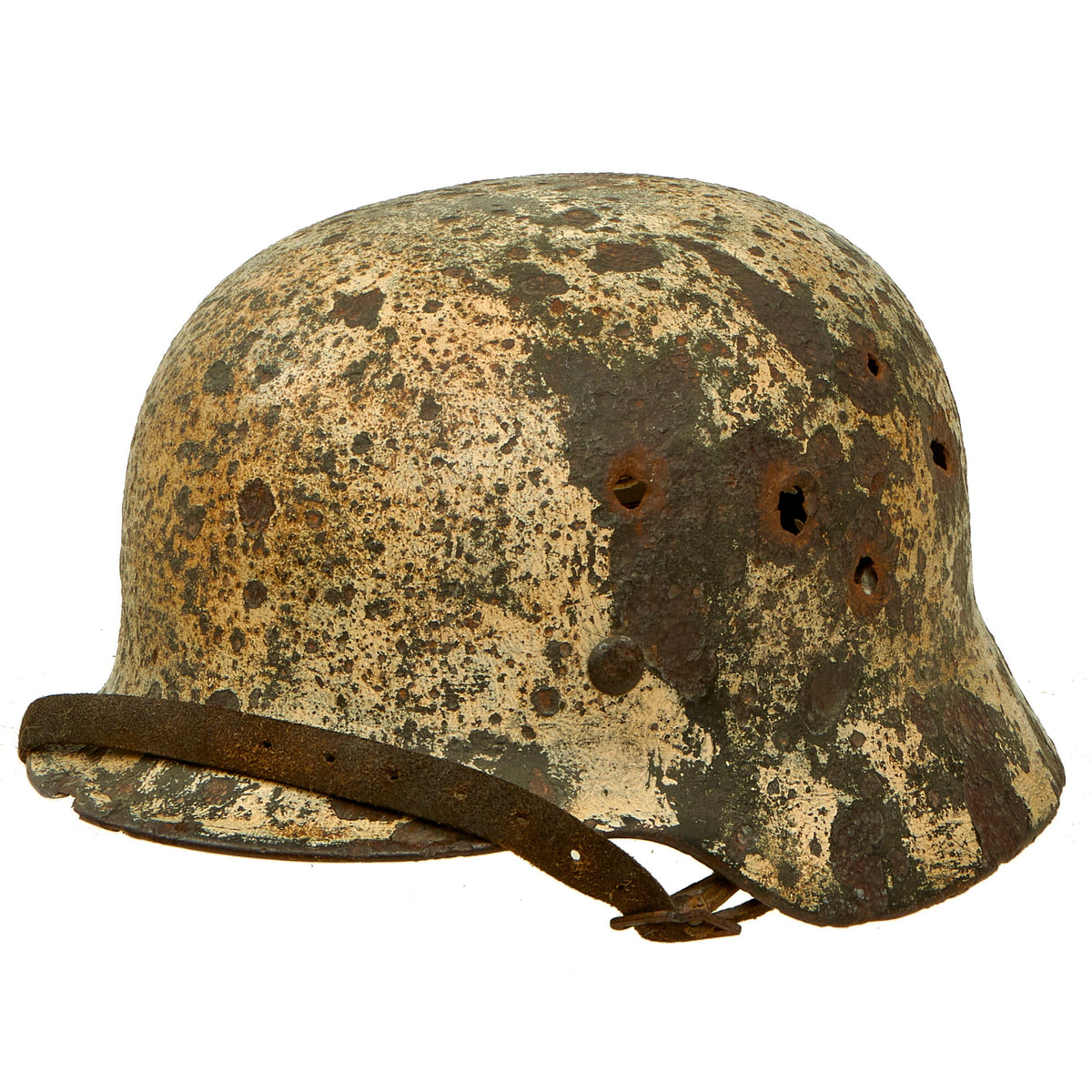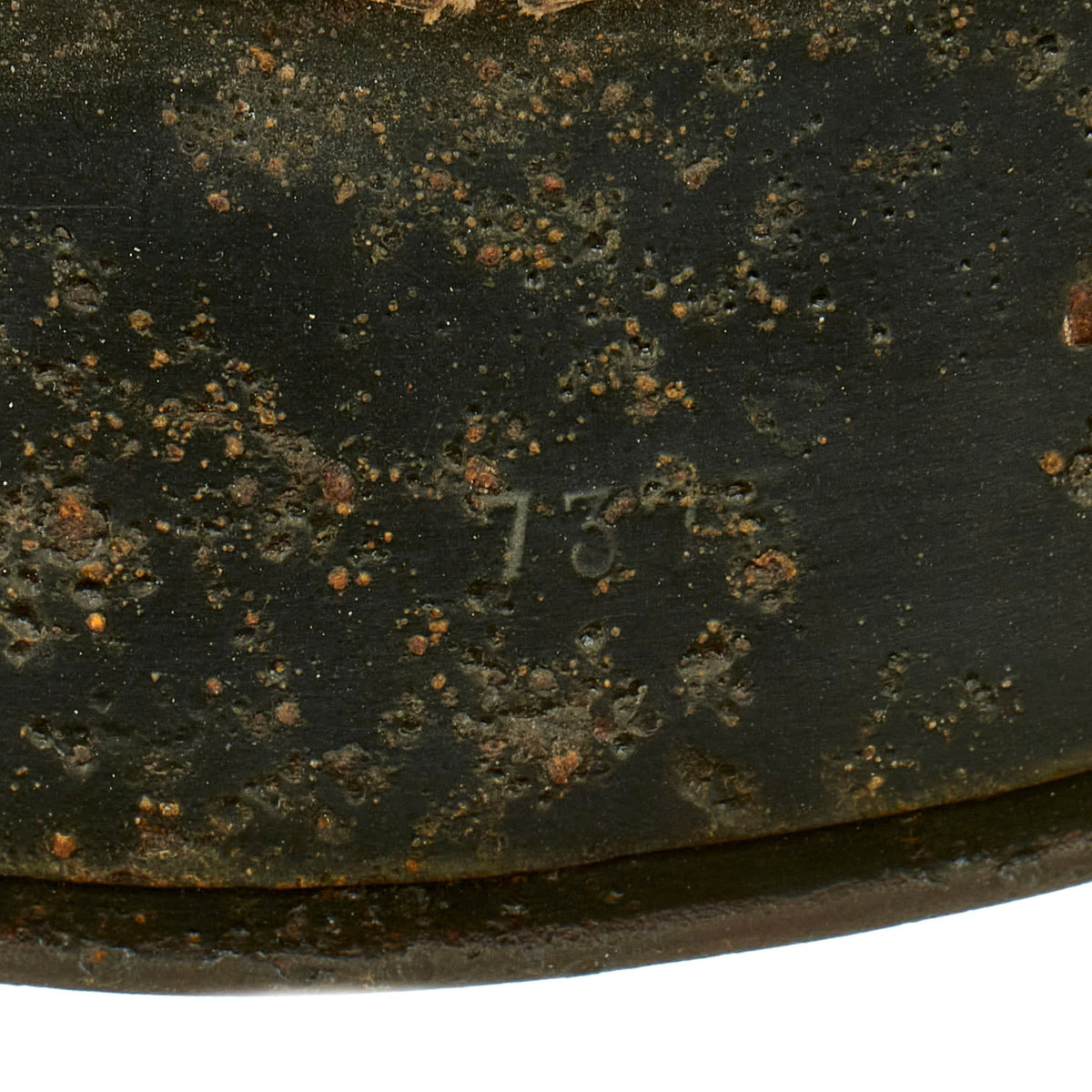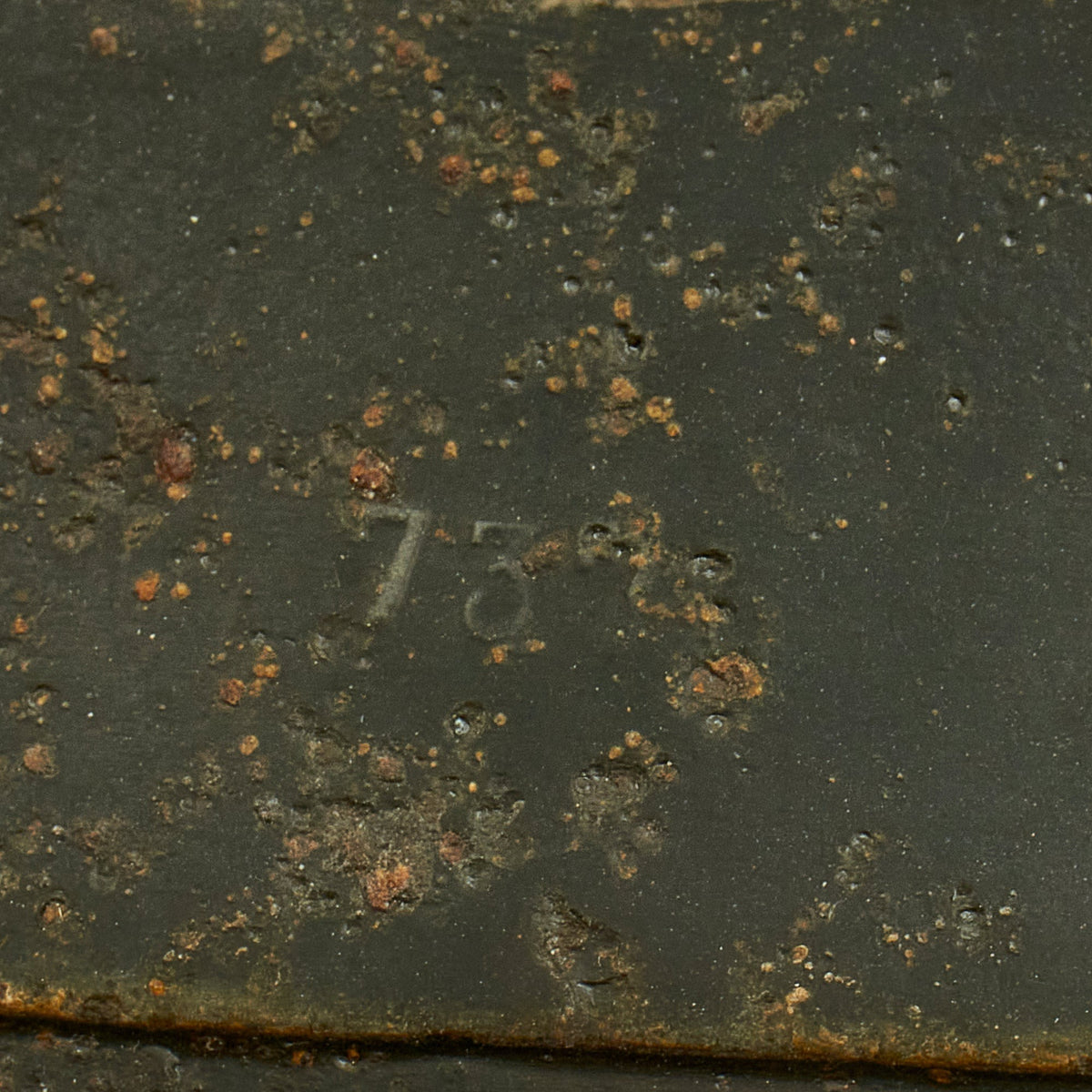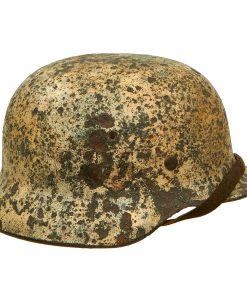Original German WWII Battle Damaged “Picked Up” M40 Single Decal SS Helmet with Liner & Chinstrap – EF66 Original Items
$ 695,00 $ 208,50
Original Item: One of a kind. This is what we all look for and can never find! This is an incredible all original Model 1940 M40 German WWII SS “Single Decal” helmet, which really looks like it has been through war! The helmet looks to have had a textured white winter camouflage applied over the original panzergrau paint, with a single SS decal applied on the right side. It then suffered damage in battle, with what looks to be shrapnel holes on the left side of the helmet, which also caused matching damage to the liner and liner band! Due to the damage, the helmet was discarded, and we assume if it was being worn at the time, that the soldier wearing it was grievously injured.
It then must have sat in the mud / water for some time, exposed to the elements, resulting in degradation of the liner as well as pit rusting on the exterior. It was however found before it had totally degraded or been buried, cleaned off, and made its way onto the collectors market. It has an impossible to duplicate look that would be more than welcome in any collection! The original SS decal, like the exterior paint, is definitely worn and damaged, probably only retained at 25%, but it is still definitively an ᛋᛋ Doppelte Siegrune (Double Sig/Victory Rune) decal.
The reverse, interior, neck guard apron is batch number stamped 7373, and the interior, left side, apron has a stamped manufacturer’s code and size, E.F.66 indicating that indicating it was manufactured by Emaillierwerke AG, of Fulda Germany in size 66. This is a nice large size that can accommodate size 58cm and 59cm liners, or 7 1/4 – 7 3/8 US. Shells of this large size are harder to find, and more valuable to a collector.
All three original liner retaining pins are present, with the original feldgrau paint well retained. The interior of the helmet still has an original M31 leather liner, however it is in relic condition, with the leather now stained and torn, though it still does retain the original top tie and 7 of 8 fingers. The early war issue galvanized steel liner band is marked on the left outer side with 66 n.A. / 59, indicating that the liner band is a size 59, intended for a 66 shell. The right side displays the full manufacture information, as well as a date, though it is hard to read due to dirt and oxidation:
SCHUBERTH-WERKE K.-G.
D. R. P.
1940
BRAUNSCHWEIG
With the very secure split pins and 1940 date, we are fairly certain that this is the original liner fitted to the helmet. There is a chinstrap present, but like the leather of the liner, it is somewhat degraded. The steel studs and buckle are present, but now rusty due to exposure to the elements.
Overall this is a wonderful “battlefield pickup” example of a “battle damaged” M40 Single Decal SS helmet, with a great patina and lots of research potential! This is an item that will only continue to appreciate in value over time.
The first “modern” steel helmets were introduced by the French army in early 1915 and were shortly followed by the British army later that year. With plans on the drawing board, experimental helmets in the field, (“Gaede” helmet), and some captured French and British helmets the German army began tests for their own steel helmet at the Kummersdorf Proving Grounds in November, and in the field in December 1915. An acceptable pattern was developed and approved and production began at Eisen-und Hüttenwerke, AG Thale/Harz, (Iron and Foundry Works), in the spring of 1916.
These first modern M16 helmets evolved into the M18 helmets by the end of WWI. The M16 and M18 helmets remained in usage through-out the Weimar Reichswehr, (National Defence Force, Circa 1919-1933), era and on into the early years of the Third Reich until the development of the smaller, lighter M35 style helmet in June 1935.
In 1934 tests began on an improved Stahlhelm, whose design was a development of World War I models. The Eisenhüttenwerke company of Thale carried out prototype design and testing, with Dr. Friedrich Schwerd once again taking a hand.
The new helmet was pressed from sheets of molybdenum steel in several stages. The size of the flared visor and skirt was reduced, and the large projecting lugs for the obsolete armor shield were eliminated. The ventilator holes were retained, but were set in smaller hollow rivets mounted to the helmet’s shell. The edges of the shell were rolled over, creating a smooth edge along the helmet. Finally, a completely new leather suspension, or liner, was incorporated that greatly improved the helmet’s safety, adjustability, and comfort for each wearer. These improvements made the new M1935 helmet lighter, more compact, and more comfortable to wear than the previous designs.
The Army’s Supreme Command officially accepted the new helmet on June 25, 1935 and it was intended to replace all other helmets in service.
The M1935 design was slightly modified in 1940 to simplify its construction, the manufacturing process now incorporating more automated stamping methods. The principal change was to stamp the ventilator hole mounts directly onto the shell, rather than utilizing separate fittings. In other respects, the M1940 helmet was identical to the M1935. The Germans still referred to the M1940 as the M1935, while the M1940 designation were given by collectors.
The last wartime upgrade to the standard helmet took place on 6 July 1942 at the request of the Army High Command. The rolled edge found on M1935 and M1940 helmets was discontinued as a measure of economy. On 1 August 1942 the first M1942 helmets were placed into production, and this was the model produced until late in the war, when most factories were captured or stood idle due to material shortages.
Fast Shipping with Professional Packaging
Thanks to our longstanding association with UPS FedEx DHL, and other major international carriers, we are able to provide a range of shipping options. Our warehouse staff is expertly trained and will wrap your products according to our exact and precise specifications. Prior to shipping, your goods will be thoroughly examined and securely secured. We ship to thousands clients each day across multiple countries. This shows how we're dedicated to be the largest retailer on the internet. Warehouses and distribution centres can be located throughout Europe as well as the USA.
Note: Orders with more than one item will be assigned a processing date depending on the item.
Before shipping before shipping, we'll conduct a thorough inspection of the items you have ordered. Today, the majority of orders will be delivered within 48 hours. The delivery time will be between 3-7 days.
Returns
The stock is dynamic and we cannot completely manage it because multiple stakeholders are involved, including our factory and warehouse. So the actual stock may alter at any time. It's possible that you may not receive your order once the order has been made.
Our policy is valid for a period of 30 days. If you don't receive the product within 30 days, we are not able to issue a refund or an exchange.
You can only return an item if it is unused and in the same state as the day you received it. You must have the item in its original packaging.
Related products
Uncategorized
Uncategorized
Uncategorized
Armoured Fighting Vehicles of the World: AFVs of World War One (Hardcover Book) New Made Items
Uncategorized
Uncategorized
Uncategorized
Uncategorized
Angolan Rebel 1970s era 60mm Inert Display Mortar from Angolan Civil War Original Items
Uncategorized
Uncategorized
Armored Burgonet Helmet & Polearm from Scottish Castle Leith Hall Circa 1700 Original Items
Uncategorized
Uncategorized
Uncategorized
Uncategorized
Uncategorized
Uncategorized
Uncategorized
